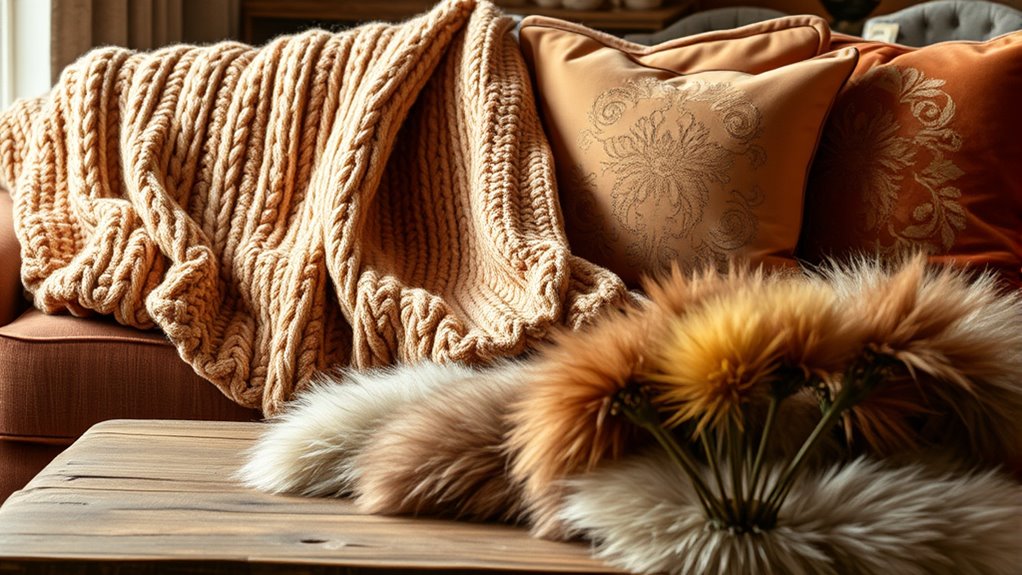To create rich textures and layered materials in your cozy interiors, mix soft fabrics like velvet, silk, and plush throws with rougher textures such as linen, wool, or burlap. Incorporate various weaves, finishes, and surface contrasts to add depth and visual interest. Combine large textured pieces with sleek surfaces for a tactile balance that invites relaxation. Keep experimenting with different materials—you’ll discover how to craft a warm, inviting space that feels uniquely yours.
Key Takeaways
- Layer different textiles like plush throws, cushions, and rugs to create warmth and visual depth in interior spaces.
- Combine smooth, shiny fabrics with rougher textures such as burlap or chunky knits for tactile contrast.
- Use surface contrasts, pairing sleek surfaces with textured accessories to enhance visual interest and tactile engagement.
- Incorporate natural fibers (cotton, wool, silk) alongside synthetic materials for diverse textures and finishes.
- Experiment with various weaves and finishes—matte, glossy, fuzzy, sleek—to craft a layered, cozy environment.

Ever wondered how to make your home feel truly warm and inviting? One of the most effective ways is through layering materials that create rich textures and visual interest. By thoughtfully combining different textile combinations, you can transform a plain space into a cozy retreat that beckons you to relax and unwind. The key lies in balancing surface contrasts—pairing smooth, shiny fabrics with rougher, tactile materials to add depth and dimension. Imagine draping a sleek silk throw over a chunky knit blanket or layering velvet cushions with textured linen covers; these surface contrasts not only enhance the tactile experience but also make your decor more dynamic.
Layer textures with silky throws and chunky knits to create a warm, inviting home.
When you mix various textiles, you’re playing with the way light interacts with different surfaces, which influences the overall ambiance. Soft, plush materials like faux fur or sherpa create a sense of warmth, while coarser fabrics such as burlap or woven jutes add an earthy, grounded feel. Combining these textures in your space helps to break the monotony of a single fabric or material, making the environment more engaging and inviting. For example, a velvet sofa paired with linen curtains and a shaggy rug can evoke a layered, cozy atmosphere that feels both luxurious and approachable.
Surface contrasts are also about scale and visual weight. Think about pairing a large, textured tapestry or a chunky knit blanket with sleek, minimalistic furniture. The juxtaposition makes each element stand out more vividly. If you opt for a smooth, polished coffee table, placing a textured tray or a woven basket on top adds a layer of visual interest. It’s all about creating a tactile dialogue between different materials, encouraging you to touch and feel everything. This tactile richness invites you to linger, making your home feel more personalized and comfort-driven.
Don’t shy away from experimenting with different textile combinations. Use throws, cushions, rugs, and curtains as your canvas for surface contrasts. Mix natural fibers like cotton, wool, and silk with synthetic options for durability and variety. Incorporate various weaves and finishes—matte, glossy, fuzzy, or sleek—to enhance the sensory experience. The goal is to craft a layered look that’s visually appealing and physically inviting. When you master the art of layering materials through textile combinations and surface contrasts, your space becomes a sanctuary that exudes warmth and personality. It’s about creating an environment that’s not just beautiful to look at but also warm to the touch, making every moment spent at home a cozy, comforting experience.
Frequently Asked Questions
How Do I Balance Different Textures Without Cluttering the Space?
To balance different textures without cluttering your space, focus on creating texture contrast to highlight each element. Use a mix of smooth and rough materials thoughtfully, ensuring they complement rather than compete. Maintain visual harmony by limiting the number of textures in one area and pairing bold textures with more subtle ones. This approach keeps your space cozy and inviting, while preventing it from feeling overwhelming or cluttered.
Which Materials Are Best for Allergy-Friendly Cozy Interiors?
Did you know that over 10% of people suffer from allergies triggered by indoor allergens? To create an allergy-friendly cozy interior, opt for hypoallergenic fabrics like tightly woven cotton or microfiber. Natural fiber options such as bamboo or hemp also offer breathability and reduce dust accumulation. These materials help keep your space warm and inviting without compromising comfort or triggering allergies, making your home both cozy and safe.
How Can I Incorporate Sustainable or Eco-Friendly Textures?
You can incorporate sustainable or eco-friendly textures by choosing sustainable textile options like organic cotton, hemp, or recycled wool for your upholstery and throws. Add eco-friendly wall coverings such as bamboo or reclaimed wood panels to bring warmth and texture. Layering these materials creates a cozy, environmentally conscious space. Focus on natural, renewable options that reduce your carbon footprint while adding rich, tactile elements to your interior.
What Lighting Enhances Layered Textures in a Room?
Imagine you’re stepping into a room, and the lighting instantly makes you feel at home. Use warm ambient lighting to softly illuminate the space, highlighting the layered textures without overpowering them. Add accent lighting, like table lamps or wall sconces, to accentuate specific textures and create depth. This combination enhances the cozy atmosphere, making every layer pop and inviting you to relax and unwind.
How Do Textures Influence the Acoustics of a Space?
Textures profoundly influence a space’s acoustics by enhancing sound absorption and providing acoustic dampening. When you incorporate soft fabrics, plush rugs, and textured wall coverings, you reduce echo and noise levels. These materials trap sound waves, making your room feel cozier and more comfortable. By layering different textured elements, you create an environment that not only looks inviting but also improves sound quality, ensuring a peaceful, acoustically balanced space.
Conclusion
By layering different materials, you create a warm, inviting space that feels both stylish and personal. Remember, incorporating diverse textures can boost comfort and visual interest effortlessly. Did you know that homes with varied textures are 30% more likely to be rated as cozy and inviting? So, don’t be afraid to mix plush throws, woven rugs, and smooth wood accents. Your layered, textured interior will invite you to relax and unwind every time you step inside.









